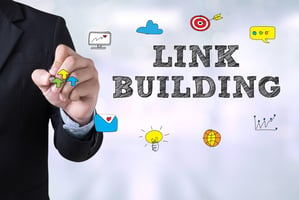Linking creates a strong chain Have you got a linking plan? Well, I've discussed backlinks recently...
Internal Linking and Why It Benefits SEO
Internal links are links between pages on the same website. These links allow users to navigate between pages and pass authority between pages on a site. Internal links are an important and often overlooked aspect of search engine optimisation (SEO). In this article, we’ll provide an in-depth exploration of internal links, including what they are, why they matter for SEO, best practices for utilising them, and tools to analyse them.
What Are Internal Links and How Do They Work?
Internal links are hyperlinks that connect web pages together within the same domain or subdirectory. For example, if you have a website www.example.com, any links between pages on that domain are internal links. These could include:
- Links in the navigation menu connecting homepage to services, about, contact, and other pages
- Links within blog posts and articles to other related posts
- Links from product category pages to individual product pages
- Footer links pointing users to various sections like Contact Us, About Us, Privacy Policy etc.
Essentially, internal links allow users to navigate seamlessly around a website by clicking links instead of having to manually find or type specific page URLs.
More importantly for SEO however, internal links pass “link equity” and authority between pages on the same domain. When page A links to page B, it passes some of its own weight and importance signals to page B. This flow of equity informs search engine crawlers of relationships and associations between pages and topics on a website.
A good internal linking structure essentially creates a web of logical connections between related content across a website. This signals value, enhances pages’ topical relevance, and allows crawlers to efficiently index interconnected content.
Why Good Internal Linking is Crucial for SEO
There are several reasons why properly utilising internal links is crucial for SEO and should be part of your overall optimisation strategy:
Distributes Authority: As discussed above, internal links pass equity and crawl budget from origination pages to destination pages. This elevates the authority and indexation priority of linked pages.
Enhances Topical Relevance: Internal links help search bots determine semantic connections and topics between different pages on a site during crawling. This improves content categorisation.
Informs Site Architecture: Thoughtful internal linking makes clearer the relationships between pages based on a site's topical architecture. Bots can understand site structure better.
Impacts Ranking Potential: Pages that accumulate more internal links have greater ability to rank for targeted keywords based on authority passed from cross-links.
Improves Crawl Efficiency: Interlinking related content pages together helps bots discover and traverse connected pages easier due to link pathways.
By building an internal link framework optimised for SEO flow and relevance, you distribute authority to pages most deserving according to your content and keywords. This enhances their ability to rank higher in search engines when users search applicable terms.
Specific Best Practices for Internal Link Building
Follow these best practices when building internal links:
Use Descriptive Anchor Text: Use anchor text that captures the topic of the page you're linking versus exact match keyword stuffing. Descriptive phrases feel more user-friendly.
Link to High-Value Pages: Homepage, About Us, Contact, Services, Blog and other top-level site-wide pages tend to attract more clicks from site visitors. Link important pages like this from site-wide menus and sidebars to pass more authority.
Contextualise In-Content Links: Integrate contextual internal links within paragraph copy of blog posts and articles where relevant to highlight related or referenced content. These feel more natural and useful to readers than just links in sidebars and footers.
Review Link Architecture Over Time: As you add or remove pages and content from a site, review the internal linking framework periodically to ensure optimal SEO structure.
Link Related Content: When creating topic-specific content pages and posts, be sure to link to other closely related content across your site where relevant for users. This helps establish semantic connections.
Avoid Over-Optimisation: While internal links are useful, be careful not to overdo it. Naturally relevant links feel best to users. Too many links just for SEO may be seen as spammy.
Can I Automate Internal Links?
With the importance of internal links for SEO, some website owners wonder if it’s possible to automate adding internal links across their site. There are a few ways this can be achieved; however, it’s not necessarily advisable for the best user experience and SEO performance.
How Internal Link Automation Works
Plugins – There are various WordPress plugins like Rank Math and Yoast SEO that can automatically insert internal links within published content. Settings allow you to define anchor text, link frequency, etc.
Software Tools – External software tools like Roast Rank can crawl your site and automatically place contextual internal links between pages based on relevancy.
The Goal of Automation
The goal is to quickly implement a dense, site-wide internal link framework designed to pass authority and topical relevance signals between important pages.
Why Automation May Cause Problems
While automation may help quickly build scale, there are downsides to consider:
Lacks Link Strategy: Plugins and crawl tools insert internal links automatically without any wider understanding of your site's architecture or priority pages. They don't know which pages on your site most need extra authority and links. They also don't understand which pages naturally attract more user clicks, and therefore pass more juice when linked from. Without this strategic lens, relevant pages that should be linked together for optimal equity flow may be missed while less important connections are created. Automated tools lack the holistic view to architect a fully strategic internal linking framework tailored for a site's priorities.
Thin Content: Excessive internal links inserted automatically without sufficient relevant content surrounding them can dilute a page's word count relative to its link density. This can make a page feel low-quality, overtly stuffed with links mainly for SEO rather than to support useful content for visitors. Too many automated links cluttering up short-form content also pulls focus away from information quality.
User Experience: Intrusive automated internal linking without contextual relevance or moderation negatively impacts actual website visitors. Too many links peppered repeatedly throughout body copy disrupts page readability making it tougher for visitors to consume informational content. Moreover, site navigation suffers when too many links lead to tangential supplementary content rather than intuitively linear next steps based on user needs. Automated tools fail to make UX considerations with internal links.
Over-Optimisation: Aggressive automated internal link building risks extensively over-optimising a site in a way that feels inorganic to search engines. Heavily linked thin content comes across manipulative rather than additive. Too many links just to boost metrics also wastes crawl budget analysing unimportant pages. Moderation is needed so automation complements rather than encumbers optimisation. The right balance results in natural interlinking aligning with quality content production.
The Best Practice
The best practice is to manually integrate contextual internal links across your site’s content in a meaningful way for visitors, supported by relevant content.
Then utilise automation selectively to complement manual linking efforts for missed opportunities without going overboard. Moderation is key – quality over quantity. Monitor linking metrics to avoid thinning content or negatively impacting user experience.
This blend of manual and automated internal links when executed judiciously results in an effective internal link framework tailored for both users and search bots.
Analysing Internal Links on Your Site
To fully analyse the internal link framework of your website, you can use a few handy tools:
Google Search Console - This free tool provides useful internal link data including:
- Indexed pages - See which site pages Google has crawled and indexed
- Inbound internal links - Pages linking to each URL on your site
- Clicks & impressions - Track which internal links get the most user clicks
Reviewing this data reveals which pages accumulate the most internal links and clicks, indicating value.
Ahrefs Site Explorer - A paid SEO tool providing extensive internal link analytics:
- Broken internal links - Find any errors 404ing
- Total internal links - See how many total internal links you have
- Links to page - Number of internal links pointing to each URL
- Pages linking - Outbound links from each page
- Page authority distribution - Authority flow between pages
This reveals exactly how internal equity is flowing between pages and any gaps needing links.
Screaming Frog SEO Spider - Free crawl tool analysing page-by-page internal linking:
- Link depth - How far pages are nested from the homepage
- Link juice graph - Visualise page authority distribution
- Page Links tab - See all outbound links per page
- Crawl visualisation map - Interactive sitemap with linking
Crawling your site provides on-page insights into optimisation opportunities around internal link placement.
By regularly reviewing internal link metrics and structures from multiple data sources, you can form an accurate picture of equity distribution and architect an optimal internal linking framework designed to boost your most important site pages.
The Takeaway
When leveraged effectively as part of an integrated SEO strategy, thoughtful internal link building creates logical connections between pages on a website. This provides immense value for both users and search engines. Users can navigate seamlessly between related content. Search bots can crawl efficiently and use link signals to categorise page topics and inform site architecture.
If you have any other questions on implementing internal links, check out our beginner's guide to SEO for even more tips.




